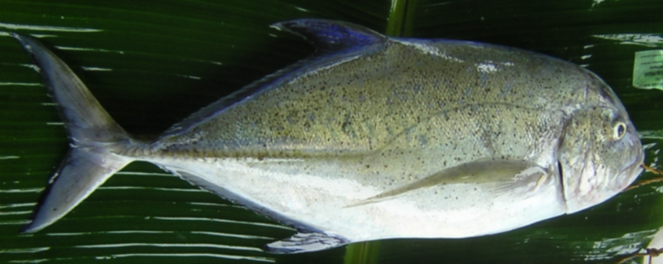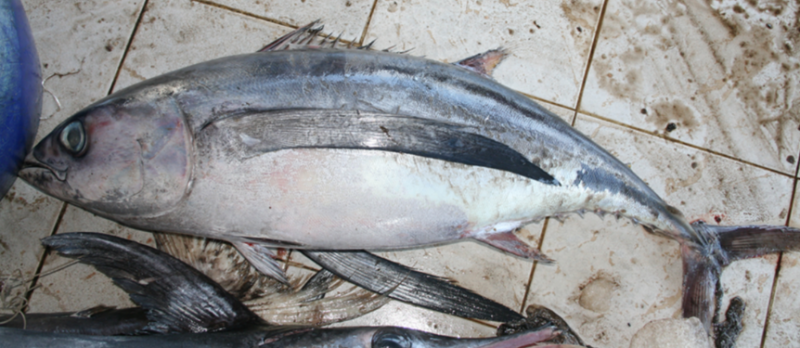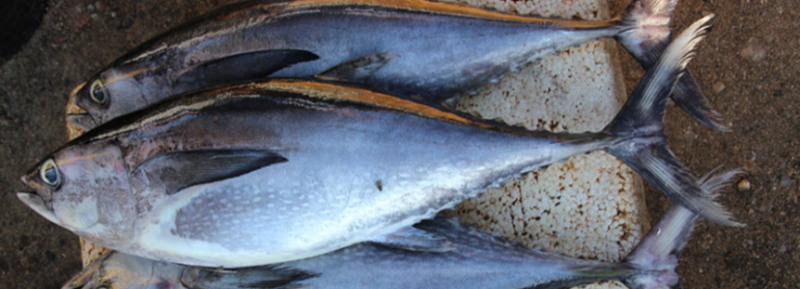Select the correct species.
Click on image to enlarge.

Good!
Select the correct species. Click on image to enlarge.

Good!
This species is Scomberomorus guttatus. Scomberomorus guttatus can be identified by having a snout shorter than the rest of the head; an elongate body and 3 irregular, horizontal rows of dark round spots.
This species is Scomberomorus guttatus. Scomberomorus guttatus can be identified by having a snout shorter than the rest of the head; an elongate body and 3 irregular, horizontal rows of dark round spots.
This species is Scomberomorus guttatus. Scomberomorus guttatus can be identified by having a snout shorter than the rest of the head; an elongate body and 3 irregular, horizontal rows of dark round spots.
This species is Scomberomorus guttatus. Scomberomorus guttatus can be identified by having a snout shorter than the rest of the head; an elongate body and 3 irregular, horizontal rows of dark round spots.
Select the correct species. Click on image to enlarge.

This species is Megalapis cordyla. Megalapis cordyla can be identified by having 51 – 59 very large scutes on the caudal peduncle and sides; a strongly, anteriorly arched lateral line, that is straight level with fourth dorsal fin spine; posterior soft dorsal and anal fins with 7 – 10 separate finlets; pectoral fins very long and bluish grey, with large black opercular spot.
This species is Megalapis cordyla. Megalapis cordyla can be identified by having 51 – 59 very large scutes on the caudal peduncle and sides; a strongly, anteriorly arched lateral line, that is straight level with fourth dorsal fin spine; posterior soft dorsal and anal fins with 7 – 10 separate finlets; pectoral fins very long and bluish grey, with large black opercular spot.
Correct!
This species is Megalapis cordyla. Megalapis cordyla can be identified by having 51 – 59 very large scutes on the caudal peduncle and sides; a strongly, anteriorly arched lateral line, that is straight level with fourth dorsal fin spine; posterior soft dorsal and anal fins with 7 – 10 separate finlets; pectoral fins very long and bluish grey, with large black opercular spot.
This species is Megalapis cordyla. Megalapis cordyla can be identified by having 51 – 59 very large scutes on the caudal peduncle and sides; a strongly, anteriorly arched lateral line, that is straight level with fourth dorsal fin spine; posterior soft dorsal and anal fins with 7 – 10 separate finlets; pectoral fins very long and bluish grey, with large black opercular spot.
Select the correct species. Click on image to enlarge.

Good job!
This species is Thunnus alalunga. Thunnus alalunga can be identified by having a streamline body shape; long pectoral fins that extend to the second finlet; a caudal fin with white posterior margin, and uniform silver colouration when dead for a extended period of time, or white/silver horizontal, irregularly spaced often broken or incomplete stripes on belly when stressed or freshly killed.
This species is Thunnus alalunga. Thunnus alalunga can be identified by having a streamline body shape; long pectoral fins that extend to the second finlet; a caudal fin with white posterior margin, and uniform silver colouration when dead for a extended period of time, or white/silver horizontal, irregularly spaced often broken or incomplete stripes on belly when stressed or freshly killed.
This species is Thunnus alalunga. Thunnus alalunga can be identified by having a streamline body shape; long pectoral fins that extend to the second finlet; a caudal fin with white posterior margin, and uniform silver colouration when dead for a extended period of time, or white/silver horizontal, irregularly spaced often broken or incomplete stripes on belly when stressed or freshly killed.
This species is Thunnus alalunga. Thunnus alalunga can be identified by having a streamline body shape; long pectoral fins that extend to the second finlet; a caudal fin with white posterior margin, and uniform silver colouration when dead for a extended period of time, or white/silver horizontal, irregularly spaced often broken or incomplete stripes on belly when stressed or freshly killed.
Select the correct species.
Click on image to enlarge.

Correct!
Select the correct species. Click on image to enlarge.

This species is Pinjalo lewisi. Pinjalo lewisi can be identified by having upper and lower profiles of head equally rounded; eyes located in middle of head; dorsal fin with 12 spines and 13 soft rays; upper sides red shading to pinkish or white below, and margin of caudal fin blackish.
This species is Pinjalo lewisi. Pinjalo lewisi can be identified by having upper and lower profiles of head equally rounded; eyes located in middle of head; dorsal fin with 12 spines and 13 soft rays; upper sides red shading to pinkish or white below, and margin of caudal fin blackish.
Correct!
This species is Pinjalo lewisi. Pinjalo lewisi can be identified by having upper and lower profiles of head equally rounded; eyes located in middle of head; dorsal fin with 12 spines and 13 soft rays; upper sides red shading to pinkish or white below, and margin of caudal fin blackish.
This species is Pinjalo lewisi. Pinjalo lewisi can be identified by having upper and lower profiles of head equally rounded; eyes located in middle of head; dorsal fin with 12 spines and 13 soft rays; upper sides red shading to pinkish or white below, and margin of caudal fin blackish.
Select the correct species. Click on image to enlarge.

Nice job!
Ruvettus pretiosus can be identified by having a moderately elongate body; a single but obscure lateral line; no keels on caudal peduncle and skin very rough, covered with bony tubercles. Other features not visible on this individual include a keel on the mid-belly and well developed pelvic fins.
Ruvettus pretiosus can be identified by having a moderately elongate body; a single but obscure lateral line; no keels on caudal peduncle and skin very rough, covered with bony tubercles. Other features not visible on this individual include a keel on the mid-belly and well developed pelvic fins.
Ruvettus pretiosus can be identified by having a moderately elongate body; a single but obscure lateral line; no keels on caudal peduncle and skin very rough, covered with bony tubercles. Other features not visible on this individual include a keel on the mid-belly and well developed pelvic fins.
Ruvettus pretiosus can be identified by having a moderately elongate body; a single but obscure lateral line; no keels on caudal peduncle and skin very rough, covered with bony tubercles. Other features not visible on this individual include a keel on the mid-belly and well developed pelvic fins.
Select the correct species. Click on image to enlarge.

This species is Grammatorcynus bilineatus. Grammatorcynus bilineatus can be identified by having 2 lateral lines joining above the pectoral fin; a body that is covered in relatively small scales and blue–green colouration above, and silvery white below.
This species is Grammatorcynus bilineatus. Grammatorcynus bilineatus can be identified by having 2 lateral lines joining above the pectoral fin; a body that is covered in relatively small scales and blue–green colouration above, and silvery white below.
This species is Grammatorcynus bilineatus. Grammatorcynus bilineatus can be identified by having 2 lateral lines joining above the pectoral fin; a body that is covered in relatively small scales and blue–green colouration above, and silvery white below.
Correct!
This species is Grammatorcynus bilineatus. Grammatorcynus bilineatus can be identified by having 2 lateral lines joining above the pectoral fin; a body that is covered in relatively small scales and blue–green colouration above, and silvery white below.
Select the correct species. Click on image to enlarge

Good job!
This species is Thunnus tonggol. Thunnus tonggol can be identified by having a large median keel with 2 smaller keels either side; caudal peduncle long; fin lobes never elongate; pectoral fin of moderate length, extending to, but not beyond first dorsal-fin base; bluish-black above, silvery below with rows of faint pale elongate spots on belly, and finlets yellowish with grey edges.
This species is Thunnus tonggol. Thunnus tonggol can be identified by having a large median keel with 2 smaller keels either side; caudal peduncle long; fin lobes never elongate; pectoral fin of moderate length, extending to, but not beyond first dorsal-fin base; bluish-black above, silvery below with rows of faint pale elongate spots on belly, and finlets yellowish with grey edges.
This species is Thunnus tonggol. Thunnus tonggol can be identified by having a large median keel with 2 smaller keels either side; caudal peduncle long; fin lobes never elongate; pectoral fin of moderate length, extending to, but not beyond first dorsal-fin base; bluish-black above, silvery below with rows of faint pale elongate spots on belly, and finlets yellowish with grey edges.
This species is Thunnus tonggol. Thunnus tonggol can be identified by having a large median keel with 2 smaller keels either side; caudal peduncle long; fin lobes never elongate; pectoral fin of moderate length, extending to, but not beyond first dorsal-fin base; bluish-black above, silvery below with rows of faint pale elongate spots on belly, and finlets yellowish with grey edges.
Select the correct species. Click on image to enlarge.

This species is Isurus oxyrinchus. Isurus oxyrinchus can be identified by having caudal fin upper and lower lobes of almost equal length; a sharply pointed snout; pectoral fins shorter than head length; a strong lateral keel; white colouration underneath and front teeth with smooth edges, curved with bent tips.
This species is Isurus oxyrinchus. Isurus oxyrinchus can be identified by having caudal fin upper and lower lobes of almost equal length; a sharply pointed snout; pectoral fins shorter than head length; a strong lateral keel; white colouration underneath and front teeth with smooth edges, curved with bent tips.
This species is Isurus oxyrinchus. Isurus oxyrinchus can be identified by having caudal fin upper and lower lobes of almost equal length; a sharply pointed snout; pectoral fins shorter than head length; a strong lateral keel; white colouration underneath and front teeth with smooth edges, curved with bent tips.
This species is Isurus oxyrinchus. Isurus oxyrinchus can be identified by having caudal fin upper and lower lobes of almost equal length; a sharply pointed snout; pectoral fins shorter than head length; a strong lateral keel; white colouration underneath and front teeth with smooth edges, curved with bent tips.